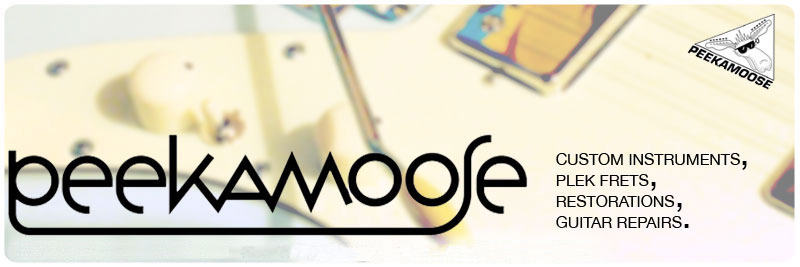-
How
much will it cost to repair my guitar?
-
How long will it take to repair my guitar?
-
What
is the turn time on a setup?
-
What
does a setup include?
-
Is
my guitar worth repairing?
-
I've
been adjusting my guitar(s) for years without any problems.
But lately, there is a buzz, an intonation problem,or (insert
problem here) that I can't repair. Can you fix it?
-
Can
you adjust my instrument while I wait?
Many jobs bill at a flat rate and some at our hourly rate.
We must evaluate the instrument to make an effective and accurate
estimate.
We receive a lot of phone and e-mail inquiries regarding job pricing
based on the owner's diagnosis. We can make phone & e-mail blind
estimates, but this method is flawed in a way that usually hits
the owner hardest. Who made the diagnosis the estimate was based
on? Not us... Asking any professional to make a repair cost projection
without doing a hands on evaluation is at best problematic. We can
quote the base rates for some types of repairs. But that does not
guaranty this will be the best or most cost effective solution.
Almost any given symptom (buzzing, high action, doesn't hold tune)
can be caused by a number of things. The only way we can be sure
what the problem is and what the correct solution will be; is to
evaluate the instrument first hand.
- The general turnaround on a setup or other light repairs is 5 to 7 working days. Often it is faster.
- Plek G& P (fret dress) is 5 - 7 days. Often it is faster.
- Re-Fret & Plek on plain boards average 14 - 21 work days. Often faster.
-
Re-Fret & Plek on lacquered boards, with a gloss finish average 14-21 days. Can be faster depends on how quickly the new lacquer sets up.
TOP
Usually four or five working days.
TOP
See the
Setup FAQ
TOP
Ask yourself the following questions:
-
1) Do you like the instrument? (Neck profile / Balance / Body
fit [your body] / Vibe)
- 2) Has the instrument proven it's stability over the time you've
had it? (is it constantly in the shop)
- 3) Do you have an emotional attachment to the instrument?
- 4) Can you go out and buy something that you like better for the
same price as the repair?
An instrument which has served reliably a number of years is usually
worth resurrection. Especially if it hasn't needed a lot of adjustments
to keep it in playing shape. Seasonal adjustments or maintenance
to off set wear and tear are to be expected. If your axe goes
out of adjustment every time you look at it cross eyed, it may
time to roll it over. But before you make a hasty decision, let
us evaluate it. There may be an explanation and correction for
the instability.
With instruments that are stable but need a lot of work, a repair
may cost as much, or more than it's purchase price. This can be
especially true if you've owned an instrument for a long time
or bought it second hand. The counter balance is you may not be
able to replace it with something you like as much for the cost
of the repair. And more importantly you can't put a price on stability.
Having an instrument that is totally stable and then tweaking
it out is an ideal situation for most players. Plus, there is
no question having custom work done for: frets, wiring, hardware
upgrades, etc will be more satisfying than production grade work
on a new factory made instrument.
If you have an emotional attachment to the instrument (it was
your first guitar/your Mom or Dad's guitar/ etc); The next question
is should you make it a player or a wall decoration. If the instrument
is going to be a player, put the work in and have it made right.
If it's going to be art, let's clean it up, make sure it won't
fall apart, and find a way you can safely display it to avoid
accidental damage.
TOP
In most cases yes. But the problem may not
be small. If it was you'd probably have fixed it yourself. See
the
Setup FAQ for more on this.
TOP
Generally, no. There are several reasons.
Most of them revolve around the premise that we want to return
your instrument in as stable and reliable state as possible. To
accomplish this, we test an instrument over a few days to make
sure it's staying where we put it. Or if this is an electronic
problem we want to take the time to fully diagnose the situation
and make the best repair.
However there are some exceptions. If we've worked on your instrument
recently, it's possible a small adjustment will do the trick and
can be done while you wait. Or, if a small repair would only take
five or ten minutes, we have a free bench, and no preexisting
deadline will be affected we will try to accommodate a player's
emergency.
If this is the first time an instrument is at Peekamoose, we recommend
you consider letting us spend the extra time to fully evaluate
an instrument's strengths and weaknesses. This involves doing
a series of adjustments, inspections, and tests, it takes a little
extra time, but you will end up with a far better understanding
of where your axe is at. Better to know if there is a weakness
that could fail and handle it in advance than discover something
at a gig.
TOP


